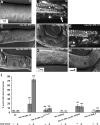RNF-121 is an endoplasmic reticulum-membrane E3 ubiquitin ligase involved in the regulation of beta-integrin
- PMID: 20357004
- PMCID: PMC2877638
- DOI: 10.1091/mbc.e09-09-0774
RNF-121 is an endoplasmic reticulum-membrane E3 ubiquitin ligase involved in the regulation of beta-integrin
Abstract
We report on the characterization of RNF-121, an evolutionarily conserved E3 ligase RING finger protein that is expressed in the endoplasmic reticulum (ER) of various cells and tissues in Caenorhabditis elegans. Inactivation of RNF-121 induced an elevation in BiP expression and increased the sensitivity of worms to ER stress. Genetic analysis placed RNF-121 downstream of the unfolded protein response (UPR) regulator protein kinase-like endoplasmic reticulum kinase (PERK). We identify PAT-3::GFP, the beta subunit of the heterodimeric integrin receptors, as an RNF-121 substrate; whereas induction of RNF-121 expression reduced the level of PAT-3::GFP in the gonad distal tip cells, inhibition of RNF-121 led to the accumulation of stably bound PAT-3::GFP inclusions. Correspondingly, overexpression of RNF-121 during early stages of gonad development led to aberrations in germline development and gonad migration that overlap with those observed after PAT-3 inactivation. The formation of these gonad abnormalities required functional ER-associated degradation (ERAD) machinery. Our findings identify RNF-121 as an ER-anchored ubiquitin ligase that plays a specific role in the ERAD pathway by linking it to the regulation of the cell adhesion integrin receptors.
Figures





References
-
- Broday L., Hauser C. A., Kolotuev I., Ronai Z. Muscle-epidermis interactions affect exoskeleton patterning in Caenorhabditis elegans. Dev. Dyn. 2007;236:3129–3136. - PubMed
Publication types
MeSH terms
Substances
LinkOut - more resources
Full Text Sources
Molecular Biology Databases
Research Materials
Miscellaneous

